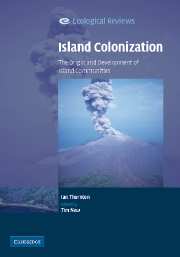Book contents
- Frontmatter
- Contents
- Editorial preface
- Acknowledgements
- PART I Theoretical and experimental studies
- PART II Natural recolonization after devastation
- PART III The recolonization of devastated islands
- PART IV Assembly of biotas on new islands
- 9 Lake Wisdom: a new island of fresh water
- 10 New islands in the sea
- 11 Anak Krakatau, Krakatau's child, b. 1933
- 12 Surtsey, Island of Surtur, b. 1963
- 13 Motmot: an emergent island in fresh water
- PART V Colonization and assembly
- References
- Index
9 - Lake Wisdom: a new island of fresh water
Published online by Cambridge University Press: 12 January 2010
- Frontmatter
- Contents
- Editorial preface
- Acknowledgements
- PART I Theoretical and experimental studies
- PART II Natural recolonization after devastation
- PART III The recolonization of devastated islands
- PART IV Assembly of biotas on new islands
- 9 Lake Wisdom: a new island of fresh water
- 10 New islands in the sea
- 11 Anak Krakatau, Krakatau's child, b. 1933
- 12 Surtsey, Island of Surtur, b. 1963
- 13 Motmot: an emergent island in fresh water
- PART V Colonization and assembly
- References
- Index
Summary
It may seem rather odd to include a lake in a chapter concerned with emergent islands, but of course for freshwater organisms a newly created lake is a pristine island of water surrounded by land, inhospitable areas which must be overcome for colonization to occur.
Lake Wisdom was discovered by Westerners in 1928, when an official party climbing the island reached about 400 m and were astonished to see, some 200 m below them, the waters of a huge lake. It was named Lake Wisdom, not because the drinking of its waters (which are clear and refreshing) leads to the getting of wisdom, but to honour Brigadier General E. A. Wisdom, Administrator of New Guinea from 1921 to 1933. Inhabitants of Long Island's sea coast, then numbering about 300 immigrants from the Siassi Islands (7 years earlier Long Island had been reported to be uninhabited), said that in the highlands there lived people whom they had never seen, but whom they blamed for the disappearance of their women from time to time.
Long Island is basically a large andesite volcano, whose explosive eruption, probably in about 1645 (see Chapter 7), resulted in the formation of a huge central caldera which takes up a third of the island's area. Over the years Lake Wisdom was formed as rain run-off filled the caldera.
- Type
- Chapter
- Information
- Island ColonizationThe Origin and Development of Island Communities, pp. 137 - 141Publisher: Cambridge University PressPrint publication year: 2007



